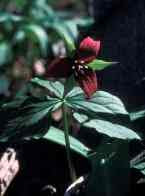As one of the human occupants of this place, I am trying to listen and heal the land from past abuses. We host one of the last remnants of forest for which Elmwood Township was named, or it was here until previous owners cut the “valuable timber”. The aerial shot on Google Earth shows a beautiful intact canopy. The timber was “thinned from above” as they say, meaning they took all the big trees and left barked-up smaller ones to sway in the wind. How do I save what’s left of that jewel, and ask the land to feed me, too? What do I do with the front yard, or the hill to the south?
As I learn more about plants and permaculture, this question becomes quite complicated. I’m getting a re-education about “weeds”. I’ve had to reconsider my attitude toward many plants in the light of new evidence. When we moved here, I saw sumac as an aggressive root-suckering plant, and autumn olive as a thorny invasive pest. Burdock was something to be given a wide berth, especially when wearing a wool sweater. Now I know sumac provides a refreshing beverage, stabilizes soil, and provides food for honeybees at a time when few other plants are blooming. Autumn olive is a nitrogen-fixing shrub, hosting microorganisms that pump nitrogen into the ecosystem. Its berries are popular with wildlife, and a related species is used as food for humans. Burdock is simply a medicinal, edible wonder plant; see its virtues as described by
Susan Weed.
Native, invasive, naturalized, pest: all categories of species we like to use. The native plant proponents would have us go back to a pre-Columbian flora. Any more recent arrivals are treated as pathogens – pull them, spray them, just get rid of them. Are they pathogens? Is baby’s breath an infection of ecosystems along the Lake Michigan shoreline? In our bodies, pathogens move in when our immune systems are weakened. Numerous cultures can teach us that sickness is not inevitable, as American medicine seems to believe. Healthy ecosystems are resilient, and resistant to minor changes, so population explosions of a single species must be a sign of something wrong. What is out of balance in these ecosystems that allows one species to become so dominant? Joe Jenkins has an interesting view of humans as pathogens in his book, Balance Point.
I’m convinced that plants simply live where they can, or are needed. If they can fulfill a role (a.k.a. fill a niche) in an ecosystem, they do. If a non-pre-Columbian plant species get established, it may be because the existing ecosystem has changed significantly. Yes, spotted knapweed can dominate a landscape, and Phragmites can take over wetlands. But knapweed has a deep taproot and can bring minerals back up to a starved topsoil. It will eventually decline as soil organic matter builds up. It is also one our biggest sources of nectar and pollen in late summer, making a honey harvest possible. It has taken over the old farms around here because the soils won’t support much else but lichens. It’s soil-building starting from square 1 ½. Phragmites thrives along shorelines and wetlands with high levels of nitrates. It is actually cleaning up the excess nutrients before they can cause a destructive algae bloom. Now, where are those nitrates coming from?
Permaculture designers and gardeners use properties of various plants to imitate a naturally-occurring ecosystem. There are nutrient accumulators that bring up nutrients with long tap roots, ground covers that hold soil, nurse plants that protect young perennials, shrubs and trees, insectary plants that attract beneficial insects, and the well-known nitrogen fixers. So there are reasons to keep burdock, lamb’s quarters, autumn olive, clover, yarrow, Queen Anne’s Lace, and many others, even stinging nettle. Perhaps we should not be so quick to judge, or slap on a label like “weed” or “invasive pest”. Perhaps these plants are trying to tell us that these ecosystems are in need of serious help! Yet we insist on shooting the messenger again, or in this case, pulling it up by the roots. It’s been said that a weed is just a plant whose virtues have yet to be discovered. If that’s the case, there are few if any weeds.
So where does that leave me in my new education? Native vs. non-native has a much diluted meaning. Goldenrod is a valued friend, and knapweed stays where it can for now; the bees love them both. Sumac has a home on the steep hill in the powerline right-of-way crossing the property, and autumn olive is to be left alone to accumulate nitrogen in those nearly-bare areas. Many others are welcomed for their food or medicinal value, or for just plain beauty, like the thousands of Dutchman’s breeches blooming in the woods right now. Who am I to say what stays or goes? The land knows what she needs, and the plants are her way of healing herself. To paraphrase John Burroughs (I think), when you pull up one plant, you find it hitched to everything else, including yourself. Now, what happens if you pull hard on your own shoelaces?
 , and they leave for the night.
, and they leave for the night.

 , and they leave for the night.
, and they leave for the night.





